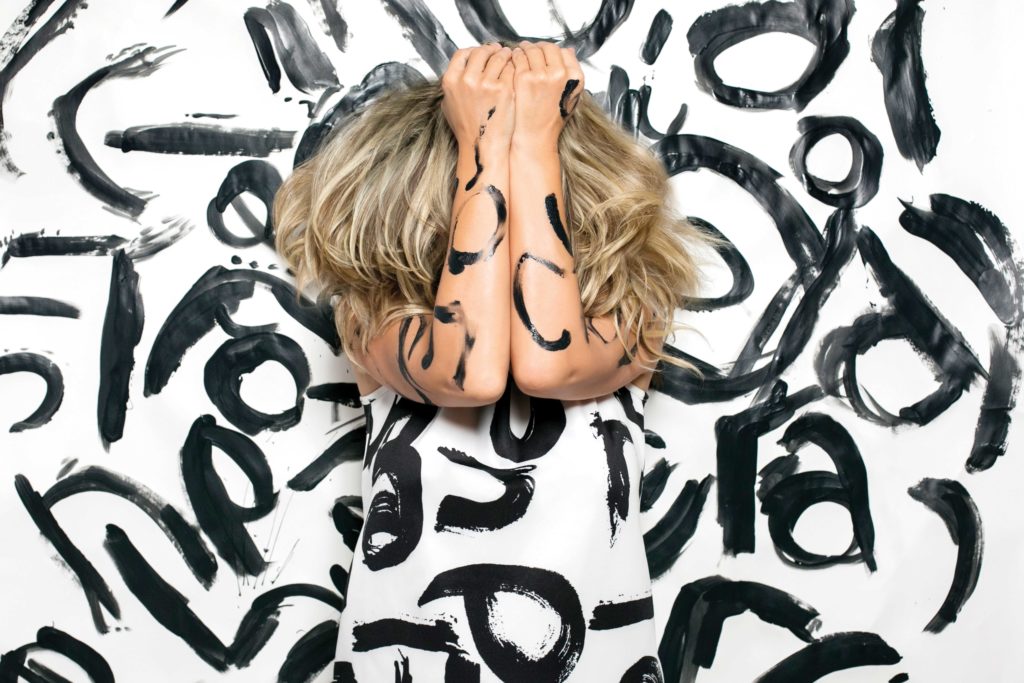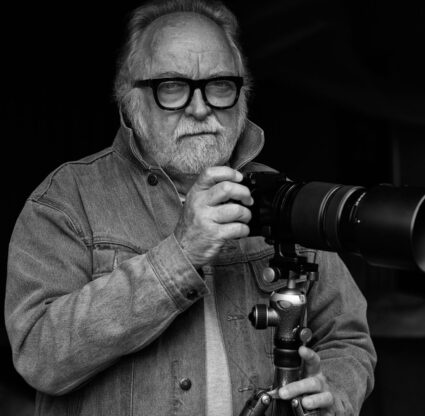On photographer Mila Bridger’s dining table, there’s a gas mask covered in plastic red and yellow chili peppers. She’s just finished vacuuming the carpet for fake diamonds. A cow’s skull painted turquoise hangs on one wall, and a mannequin wearing a crown of yellow flowers stands by the front door. Her black cat, Nola, pads across the living room, and somewhere out of sight three other little monsters—Tiki, Mishka and Sushi—are hiding. Her partner, Ryan Darling, is in another room, steadfastly working on his computer. Out front, a mat on the doorstop of her Marco Island home says, fittingly, “Come back when you have catnip and Polish vodka.”
When people describe Bridger, something they say again and again: This girl lives. It comes from her enthusiasm for life, how she approaches her art, the way she gobbles up good books and lavishes affection on everyone (people and cats included), and how she fills her home with a mad, quirky, vibrant energy.
“Mila is maybe one of the most fearlessly unique individuals I’ve ever met,” says friend Destiny Haggett, who met Mila through the Sidney & Berne Davis Art Center in downtown Fort Myers. “I always say I wish I could see the world the way Mila does, a mix of beauty and chaos and fun.”
 Originally from the city of Koszalin in the northwest of Poland, the 39-year-old artist is best known for her abstractly surreal, color-saturated photographs featuring what she labels as manufactured fantasy. Often her models are wearing gas masks, some elaborately decorated, as they prepare for the end of the world in lavish style.
Originally from the city of Koszalin in the northwest of Poland, the 39-year-old artist is best known for her abstractly surreal, color-saturated photographs featuring what she labels as manufactured fantasy. Often her models are wearing gas masks, some elaborately decorated, as they prepare for the end of the world in lavish style.
“I am customizing gas masks,” Bridger says, laughing. “It’s the end of the world, and you want to look your best.”
The masks appear again and again in her work, and Bridger says she can point to a single moment when the motif entered her life. Her mother was the curator of the modern art section of a museum in Poland, and when Bridger was a small child her mother brought in an exhibit on the Halmstad group, Scandinavian surrealists and cubists from the 1920s and ’30s. There was a particular painting from the exhibit—Den Borgerliga Moralen i Skriftestol by Erik Olson—that captivated the young Bridger. She hung a poster of the work on her bedroom door and refused to let anyone remove it for years. At the bottom center of the painting, a gas mask hangs on the back of a chair.
Bridger admits that some of her fascination with the masks probably also comes from the lingering remnants of Cold War communism that she grew up with in Poland.
“In high school we had one year of prep for disasters,” she says. “We learned how to wear a gas mask and how to put a gas mask on somebody else.”
Over the years she began to collect them, and as people found the masks in Army surplus shops they’d send them her way.
“My dad will always send them to me. My uncle, my dad’s brother, lives in Denmark, where there are so many military stores. Between the two of them, I always have them. And when I see one of them, I’ll always get it.”
Cesar Aguilera, an artist who has collaborated with Bridger on several projects, tells about the first time he met Bridger at a Halloween party.
“She was dressed as a creepy person in oversized old clothes with a gas mask on,” he says. “The whole party she would not take off the mask.”
When it comes to her artistic muses, Bridger lists Salvador Dalí, Peggy Sirota, Sakir Gokcebag, Zdzislaw Beksinksi and Richard Avedon. Her photographic influence comes largely from hyper-real photographer David LaChapelle—“I’m absolutely obsessed with him. I have his books, but I don’t open them. I’m afraid I might have an idea, and he’s already done it”—as well as French street photographer Henri Cartier-Bresson.
“I love his black and white, the form, the way it’s accidental but it’s not. It’s just pure art.”
Yet Bridger says she looks more to the classic painters than modern photographers for influence, particularly the Dutch masters and baroque paintings of the 17th century.
“My mom is an art historian, and I literally grew up with the history of art, the history of painting. When I was tiny and in the crib screaming my head off, she would come and open the Encyclopedia of Art to the little Infanta Margarita by Velazquez. The painters, they knew what they were doing. Now we’re all about abstract. Everyone’s an artist now. Everyone has a camera. But just having a camera, having the parts, isn’t enough.”
A good photographer, it might be argued, has a particular way of being in the world.
“When I see something in my head,” Bridger says, “I have to do it or I explode. It’s like, I need someone to come here right now and then—” She exhales a slow breath. “When it’s done, I can relax.”
In her head now? A series of photographs inspired by her Marco surroundings.
“I have this idea—I have just one image now called Spring Cleaning. Discombobulated Spring Cleaning. One person vacuuming the grass, another person ironing a palm tree and someone else watering the flowers with champagne. This area is so exotic for me. I was raised by the Baltic Sea, an angry ocean. Sometimes it freezes in the winter. It’s never turquoise, always dark blue.”
This pursuit of exoticism is a current that runs through Bridger’s life, especially in her relationship with her father and the madcap voyages the two of them take across the globe. Stanley Metelski—Tata, as Bridger calls him—is Czech. Trained as a nuclear physicist in Poland, he went to work in the airline industry and when he retired was given lifetime buddy passes. Bridger has become his favorite traveling companion.
“We want to see as much as possible,” she says.
The two regularly fly off to far-flung destinations; the harder to reach the better. They fly standby, with only a backpack for luggage, her father dressed in a suit and Bridger in a skirt and heels.
“You have to respect the airline in the old-fashioned way,” she says. “No way I can wear jeans. I have my special outfits for travel.”
The moment they sit down—often in first class—the pair order drinks. They both have strong personalities, and a drink helps smooth their rough edges.
 “My Tata says ‘killing germs’ to mean ‘have a drink.’ We need to kill germs as soon as we get on the plane.”
“My Tata says ‘killing germs’ to mean ‘have a drink.’ We need to kill germs as soon as we get on the plane.”
They order the same drink, cognac, and kill germs all the way to their destination. They’ve visited Chile, Ecuador, Dubai, Hong Kong, Japan, Pulau, Yap and the Marshall Islands, where the United States performed nuclear tests in the 1940s and ’50s. Recently, the two took only their second U.S. trip together, a flight to San Antonio and then an eight-hour drive south to the Texas town of Marfa, famous for its Prada Marfa art installation as well as a mysterious phenomenon known as the Marfa lights.
“Tata is obsessed with UFOs,” Bridger says.
She has a photo, perhaps the best of the trip, snapped casually on her iPhone but with all of her artistic hallmarks: saturated colors, an eerie end-of-the-world feel and her father as the model—not in a gas mask this time, but in a giant stuffed panda head.
“I just had it in my backpack,” Bridger says, shrugging.
There may be fewer trips in the immediate future, because following this interview Tata lost all but the foundation and frame of his Houston home in Hurricane Harvey. He has begun to rebuild, and Bridger’s friend Destiny Haggett has set up an account for donations at gofundme.com/hurricane-harvey-tata-relief.



